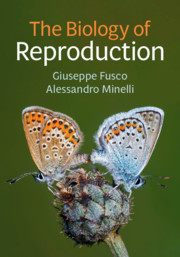Crossref Citations
This Book has been
cited by the following publications. This list is generated based on data provided by Crossref.
Arthur, Wallace
2020.
The Biological Universe.
Minelli, Alessandro
2020.
Disciplinary Fields in the Life Sciences: Evolving Divides and Anchor Concepts.
Philosophies,
Vol. 5,
Issue. 4,
p.
34.
van Gestel, Jordi
2020.
Slow lane to collectivity.
Nature Ecology & Evolution,
Vol. 4,
Issue. 3,
p.
292.
Nuño de la Rosa, Laura
Pavličev, Mihaela
and
Etxeberria, Arantza
2021.
Pregnant Females as Historical Individuals: An Insight From the Philosophy of Evo-Devo.
Frontiers in Psychology,
Vol. 11,
Issue. ,
van Gestel, Jordi
Wagner, Andreas
and
Barton, Nick H.
2021.
Cryptic surface-associated multicellularity emerges through cell adhesion and its regulation.
PLOS Biology,
Vol. 19,
Issue. 5,
p.
e3001250.
Rötheli, Tobias F.
2021.
One Plus One Equals Two: More or Less.
SSRN Electronic Journal ,
Minelli, Alessandro
2021.
On the Nature of Organs and Organ Systems – A Chapter in the History and Philosophy of Biology.
Frontiers in Ecology and Evolution,
Vol. 9,
Issue. ,
Hojsgaard, Diego
and
Schartl, Manfred
2021.
Skipping sex: A nonrecombinant genomic assemblage of complementary reproductive modules.
BioEssays,
Vol. 43,
Issue. 1,
Sommaggio, Daniele
Fusco, Giuseppe
Uliana, Marco
and
Minelli, Alessandro
2021.
Possible Epigenetic Origin of a Recurrent Gynandromorph Pattern in Megachile Wild Bees.
Insects,
Vol. 12,
Issue. 5,
p.
437.
Albecker, Molly A.
Wilkins, Laetitia G. E.
Krueger-Hadfield, Stacy A.
Bashevkin, Samuel M.
Hahn, Matthew W.
Hare, Matthew P.
Kindsvater, Holly K.
Sewell, Mary A.
Lotterhos, Katie E.
and
Reitzel, Adam M.
2021.
Does a complex life cycle affect adaptation to environmental change? Genome-informed insights for characterizing selection across complex life cycle.
Proceedings of the Royal Society B: Biological Sciences,
Vol. 288,
Issue. 1964,
DiFrisco, James
and
Wagner, Günter P.
2022.
Body Plan Identity: A Mechanistic Model.
Evolutionary Biology,
Vol. 49,
Issue. 2,
p.
123.
Minelli, Alessandro
2022.
Two-way exchanges between animal and plant biology, with focus on evo-devo.
Frontiers in Ecology and Evolution,
Vol. 10,
Issue. ,
Fusco, Giuseppe
and
Minelli, Alessandro
2023.
Descriptive versus causal morphology: gynandromorphism and intersexuality.
Theory in Biosciences,
Vol. 142,
Issue. 1,
p.
1.
Henshaw, Jonathan M.
Bittlingmaier, Markus
and
Schärer, Lukas
2023.
Hermaphroditic origins of anisogamy.
Philosophical Transactions of the Royal Society B: Biological Sciences,
Vol. 378,
Issue. 1876,
Cortés-García, David
Etxeberria, Arantza
and
Nuño de la Rosa, Laura
2024.
The evolution of reproductive characters: an organismal-relational approach.
Biology & Philosophy,
Vol. 39,
Issue. 5,
Peretti, Alfredo V.
Calbacho-Rosa, Lucía S.
Olivero, Paola A.
Oviedo-Diego, Mariela A.
and
Vrech, David E.
2024.
Rules and Exceptions in Biology: from Fundamental Concepts to Applications.
p.
223.
Vatanparast, Mohammad
Madsen, Palle
Sagheb-Talebi, Khosro
Larsen, Jørgen Bo
Ayan, Sezgin
and
Hansen, Ole K.
2024.
Genomic diversity of major tree species in the Eurasian relict forests of northern Iran.
Tree Genetics & Genomes,
Vol. 20,
Issue. 5,
Rizos, Iris
Frada, Miguel J.
Bittner, Lucie
and
Not, Fabrice
2024.
Life cycle strategies in free‐living unicellular eukaryotes: Diversity, evolution, and current molecular tools to unravel the private life of microorganisms.
Journal of Eukaryotic Microbiology,
Vol. 71,
Issue. 6,
Fábregas-Tejeda, Alejandro
and
Sims, Matthew
2025.
On the prospects of basal cognition research becoming fully evolutionary: promising avenues and cautionary notes.
History and Philosophy of the Life Sciences,
Vol. 47,
Issue. 1,
Sims, Matthew
2025.
Slime Mould and Philosophy.



